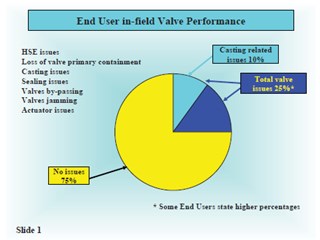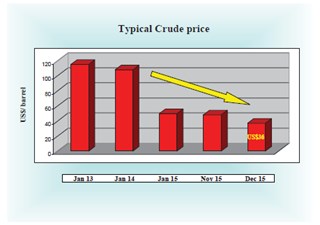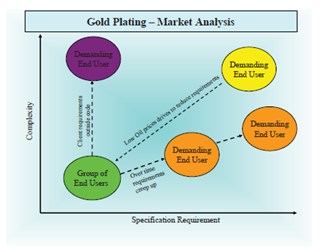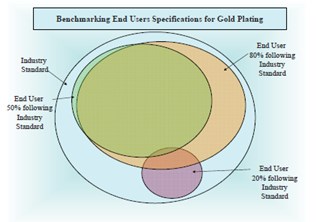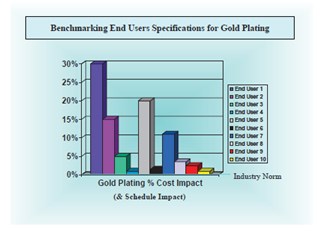With sustained low Global oil prices into 2016 the knock on within the industry will continue. Further aspects of the supply chain will be affected with reduction in expenditure and projects, redundancies, company re-structuring, travel restrictions etc. End users have, and will continue to, streamline their investments and expenditure while the oil prices remain low well into 2016.
Having now experienced many of these boom and bust cycles one area that is guaranteed to be looked at is END USER SPECIFICATIONS. These specifications will be challenged to see if the requirements are relevant or excessive. If the specifications are excessive then often the term used is Gold Plating.
- Testimony of my first experience of Gold Plating
- How and why do end user specifications run the risk of being Gold Plated?
- How do end users control / not control their specifications to prevent Gold Plating?
This article will cover;
- Benchmarking end users’ specifications for Gold Plating
- Some examples of why additional requirements are specified. Is this Gold Plating necessary?
- How should the supply chain respond to Gold Plating?
Benchmarking end users’ specifications for Gold Plating
When using the control document for additions to International Standards resistance from engineers is common. However when the logic and reason behind the process is fully explained the majority of engineers see the benefits. For example it actually makes the end user requirements clearer and more effective to implement through the supply chain. The importance of HSE and Safety is ensured with any appropriate attention by the end user.
i have benchmarked various end user specifications by comparing them with each other and with the requirements above international standards. Experience shows 5% to 10% cost impact has been accepted by many end users. Others have been identified up to 30% and higher…maybe these end users are out of control? They either do not know this or do not care.
Are there any differences between upstream and downstream?
Yes and no. (Not a helpful answer). From my observation upstream tends to be more Gold Plated than downstream. Generally when the business unit’s return on investment is high such as in upstream then Gold Plating is less likely to be challenged. With tight margins and over capacity downstream cost reduction programs are more active with less Gold Plating. Typical changes that affect the procurement and valve supply chain include;
- Design restrictions / additions
- Excessive prototype testing
- Chemical composition restrictions
- Higher impact testing
- Tight control on sealing components
- Restriction on sub-suppliers, castings, forgings etc
- Extra NDT examination, XRay, UT, mpi, dye penetrant etc.
- Material certification additions
- Fugitive emission interpretation & testing
- Hydrotest changes, test pressures / test duration times
- Excessive painting requirements above normal
Some examples of why additional requirements are specified. Is this Gold Plating?
Whenever an end user has an operational failure it is normal for a root cause analysis be undertaken. Slide 1 illustrates end user in-field valve performance showing up to 25% failures. Obviously a failure that results in loss of containment is most critical. Sometimes the original specification is incorrect, poor maintenance or incorrect operation is identified. This is dealt internally within the end user.
However, often the root cause is identified as the valve manufacturer. Analysis of this data clearly shows that the probability of failure is more likely to be linked with new unproven manufacturers in the valve design itself or a commercially more attractive cost. The more established proven manufacturers do tend to perform better. (A few end users do not hold this view). In the valve segment some end users are experiencing failures in operation that is attributed to the valve supply chain. Hence some end users require extra controls and inspection etc. to help alleviate the problems.
Unfortunately these extra requirements are often implemented globally affecting all valve suppliers, whether they have been at fault or not. This regretfully applies to the UK Valve supply chain. Often this is interpreted as Gold Plating. Clearly castings continue to be a major issue in the industry with low cost country production. This will get worse as evidence of the industry accepting high end materials is becoming more and more common. Also low alloy steels are now being sourced. Extra NDT is called for and high / longer hydrotest times. Nitrogen / helium testing is requested. Gold Plating? (An end user re-tested several thousand valves on a project to find up to 10% failures plus other issues were found.)
Explosive decompression of O rings constantly occurs as unproven designs or suppliers are used. I am currently discussing this with an end user and valve manufacturer. Also bonnet and stem seal failures occur. Extra material/ design controls / testing are requested.
Gold Plating? When end users have disassembled valves that have failed often the internals are incorrect in design or materials. Often “equivalent materials are used” and they are not equivalent. Hence a hold point in the manufacturing is introduced to independently check the internals before assembly.
Gold Plating?
Valve by-passing occurs. The end user increases the testing requirements. Gold Plating? Actuator design inadequate resulting with failures to operate / seizing. Also poor mounting design cause failures. The end user increases their
requirements.
Gold Plating?
Regretfully the list goes on and on….
Final thoughts on how the supply chain should respond to Gold Plating
I hope these articles have been informative by giving an insight into end users’ extra requirements and hopefully explain how and why Gold Plating occurs. End users’ drive is for top HSE, Operational and Maintenance performance. Yes, some end users do over specify and Gold Plate whilst others are more reasonable with effective controls. I am sure you have many other Gold Plating examples. I hope they are not “too demanding”. I know it is protocol to accept the end user requirements as they are “King”. Just to say some manufacturers do highlight the opportunity of different options and are accepted. Food for thought? If I can offer any assistance or comments then please do not hesitate to contact me.
Until next time…..
Barrie Kirkman, BSc CEng MIMechE, writes a regular column for Valve World, bringing his own personal views from inside the valve business. Barrie can be reached on: barriekirkman@ntlworld.com.



